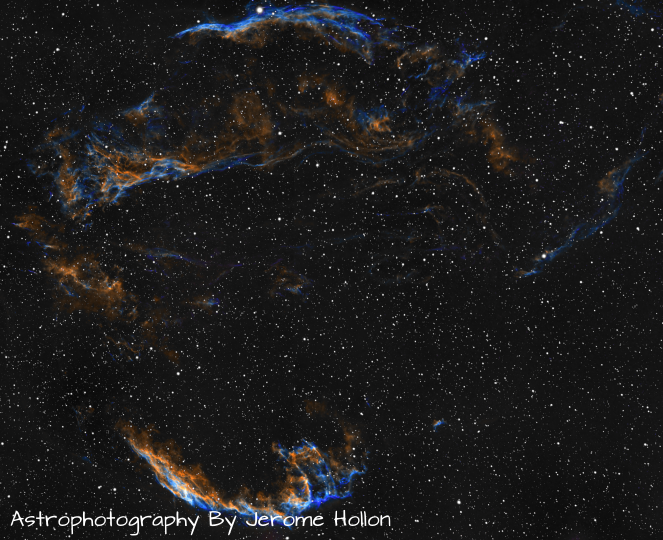Cygnus Loop
Sep 19, 2022
Cygnus Loop
| Other names | Veil Nebula |
| Type | Supernova Remnant |
| Distance | 1,470 ly |
| Size | 110 ly |
| Location | Cygnus |
| Captured | Sep 19, 2022 |
| Capture type | Narrowband (SHO), 2 Panel Mosaic |
| Total time | 14 hours |
| Frames | SHO 14x600' each |
| Telescope | AT80EDT |
| Camera | ZWO ASI294mm |
| Tripod | CGEM-70-EC |
Cygnus Loop, 2 Panel Mosaic
This is the Cygnus Loop (also known as the Veil Nebula), first discovered by the English astronomer William Herschel in 1784. It is a supernova remnant located in the constellation Cygnus, about 1,470 light-years away from us. The nebula spans approximately 3 degrees across, which corresponds to a physical size of about 110 light-years. The Cygnus Loop is the result of a supernova explosion that occurred around 8,000 years ago, when a massive star at least 20 times the mass of the Sun reached the end of its life and exploded.
The Cygnus Loop is composed of several overlapping structures, including the Western Veil, the Eastern Veil, and Pickering’s Triangle. These structures are ionized by the shock wave from the supernova explosion, which heats up the gas to millions of degrees and causes it to emit X-rays. The Cygnus Loop is one of the largest and brightest supernova remnants in the sky, and it is visible to the naked eye as a faint, wispy patch in the constellation Cygnus.
The Cygnus Loop is so large that it spans an area of the sky about 36 times the size of the full Moon. The Western Veil of the Cygnus Loop is also known as the Witch’s Broom, due to its resemblance to a broomstick.
